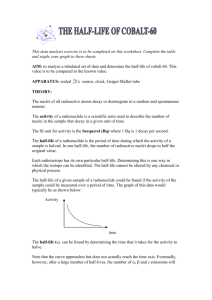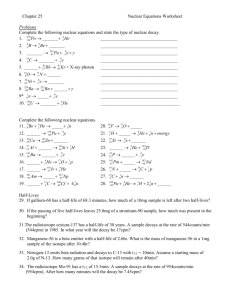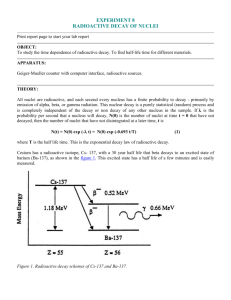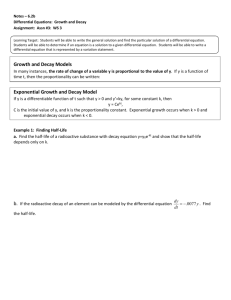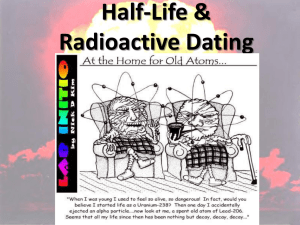Radioactivity Lab
advertisement
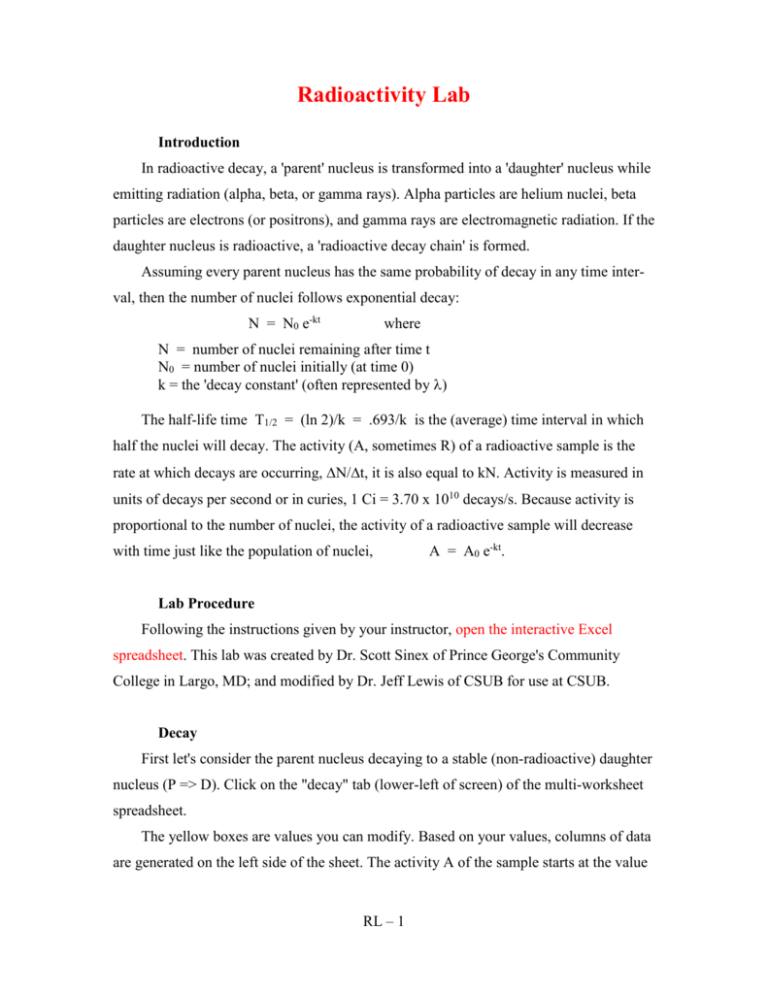
Radioactivity Lab Introduction In radioactive decay, a 'parent' nucleus is transformed into a 'daughter' nucleus while emitting radiation (alpha, beta, or gamma rays). Alpha particles are helium nuclei, beta particles are electrons (or positrons), and gamma rays are electromagnetic radiation. If the daughter nucleus is radioactive, a 'radioactive decay chain' is formed. Assuming every parent nucleus has the same probability of decay in any time interval, then the number of nuclei follows exponential decay: N = N0 e-kt where N = number of nuclei remaining after time t N0 = number of nuclei initially (at time 0) k = the 'decay constant' (often represented by ) The half-life time T1/2 = (ln 2)/k = .693/k is the (average) time interval in which half the nuclei will decay. The activity (A, sometimes R) of a radioactive sample is the rate at which decays are occurring, N/t, it is also equal to kN. Activity is measured in units of decays per second or in curies, 1 Ci = 3.70 x 1010 decays/s. Because activity is proportional to the number of nuclei, the activity of a radioactive sample will decrease with time just like the population of nuclei, A = A0 e-kt. Lab Procedure Following the instructions given by your instructor, open the interactive Excel spreadsheet. This lab was created by Dr. Scott Sinex of Prince George's Community College in Largo, MD; and modified by Dr. Jeff Lewis of CSUB for use at CSUB. Decay First let's consider the parent nucleus decaying to a stable (non-radioactive) daughter nucleus (P => D). Click on the "decay" tab (lower-left of screen) of the multi-worksheet spreadsheet. The yellow boxes are values you can modify. Based on your values, columns of data are generated on the left side of the sheet. The activity A of the sample starts at the value RL – 1 you set but drops with time in accordance to the half-life you specify. The upper plot shows the fractional activity (A/A0) as a function of time, an exponential decay curve. Vary the half-life value (use values between .5 and 25) and watch how the decay constant, A-values, A/A0-values, and graph change. [Write your answers on a separate piece of paper.] (Q1) When is the decay constant largest? (Q2) Describe how increasing the half-life changes the A/A0 versus time graph. Vary the starting activity value while leaving the half-life fixed. (Q3) Describe how changing the starting activity changes the A/A0 versus time graph. Explain the result. If we take the activity formula (A = A0 e-kt), divide both sides by A0, and take the natural log of both sides we get ln(A/A0) = -kt . This is the form of the equation for a straight line (y = mx + b) with y = ln(A/A0), x = t, b = 0, and slope m = -k. Now look at the green line in the lower graph. That is a plot of ln(A/A0) versus time and the slope is the negative of your current decay constant value (-k). This "semilog" plot is a convenient way to analyze exponential decay because the resulting plot is a straight line. The red line in the lower graph is a plot of log(A/A0) versus time. That plot also gives a straight line but the slope is not -k. (Q4) Figure out what the slope of the base-10 log plot means. Start with the activity formula, take the log of both sides and use that log ab = b log a. (Q5) Suppose a sample has an activity of 10 Ci and a half-life of 1 hour. After how much time will the activity be exactly 1 Ci? Answer this by putting values into the exponential decay formula (start by calculating k= (ln 2)/T1/2) and solving for t; not by using Excel. Daughter Click on the "daughter" tab. We are now calculating and plotting nuclei numbers rather than activity; we are still considering the case of a stable daughter. Note that (P + D) stays constant. This may seem obvious but it might not be true for samples in nature for a variety of reasons. Some of those reasons are: RL – 2 1. Atoms of P may move into or out of the sample from the surroundings. 2. Atoms of D may move into or out of the sample from the surroundings (particularly if the D element is gaseous). 3. P may be able to decay into nuclei other than the D type. 4. D may be unstable and decay into something else. Vary the half-life while keeping an eye on the changes to the D/P ratio. (Q6) Does D/P grow faster for large or small half-lives? (Q7) Using P = P0 e-kt and P0 = P + D, derive the result ln ( 1 + D P ) = kt This means that the elapsed time (t) can be calculated if the ratio D/P is known. This result only applies if D = 0 at time zero, and only if the other assumptions mentioned above are true. More complex formulae exist for those other situations. Usually the D/P ratio can be measured for a sample by mass spectroscopy. (Q8) How old is a sample of 27Mg if the D/P ratio is 1.5 and the half life is 9.45 min (T1/2= 9.45 m). You can use the spreadsheet to double-check your calculated result. Unstable Daughter Click on the "unstable daughter" tab. Now we consider a decay chain P => D => S (S for Stable). There are now two half-lives to consider, that for the decay of Parent into Daughter and that for the decay of the Daughter into Stable. For your half-life and starting number choices, the program displays the number of nuclei at each time and plots of those numbers. We assume the conditions are such that P + D + S will be constant. Since we assume all the nuclei start as type P, the number of P at a later time just depends on the decay rate of P. The number of D nuclei depends on both the rate that P are decaying into D and the rate that D are decaying to S. The number of S nuclei should grow fastest if the P are quickly decaying into D and those D are quickly decaying into S. (Q9) Use the half-life values specified below and observe how the plots change – try to understand why the graphs look the way they do. For each case note in your table which nucleus (P, D, or S) was most numerous at time 15. RL – 3 Parent Daughter Most Common Half-Life Half-Life at Time 15 1 25 these instructions so 1 1 make your own table on 25 1 your answer sheet. 25 25 You're not turning in Total Radioactivity Click on the "tot rad" tab. This page is the same as the last page but we've added a column called "Tot Act" meaning the total activity of the sample. Remember that the activity is the decays per time rate. The rate at which P nuclei are decaying depends on how many P nuclei are present and the half-life for P decays. The rate at which D nuclei are decaying depends on how many D nuclei are present and the half-life for D decays. Enter a value of 5 for the half-life of P nuclei, use any value you want for the halflife of D decays. The total activity at time zero should read 139. Because only P nuclei were present at time zero, this means the P nuclei were decaying at a rate of 139 per time interval. Yet on the next line you should see that there were 871 nuclei, 129 actually decayed not the 139 expected. That happened because, during the minute, the number of P nuclei decreased and its decay rate decreased during the minute. The average decay rate for P's during the minute was 129, hence the 871 left after one minute. While the activity of P nuclei decreases throughout the period, the activity of D will increase or decrease depending on whether the number of D nuclei is increasing or decreasing. (Q10) Using T1/2(P) = 8 and T1/2(D) = 4, consider the interval from time 2 to time 3: (a) How many P nuclei decayed during that interval? [Just calculate the difference between P values at times 2 and 3.] (b) How many D nuclei decayed during that interval? [Just calculate the difference between S values at times 2 and 3.] (c) What was the total activity during that minute based on your answers to parts (a) and (b)? RL – 4 (d) What were the total activities (Tot Act) listed by the program for the start and end of that one-minute period? [If your answer to (c) is not between or the same as the values in (d), then you've miscalculated.] (Q11) Fill in a table like that shown below. Set the half-lives to the values given in the first two columns and write in the total activity values given on the spreadsheet for times 0 and 15 into the appropriate columns. By looking at the rates that P is decreasing and S is increasing, decide whether the activities at times 0 and 15 were mostly due to the parent (P), the daughter (D), or both about equally (B). T1/2 (P) T1/2 (D) 2 2 2 25 25 25 25 2 Tot Act at t=0 Due to Tot Act t=15 Due to (Q12) If you were measuring a D/P ratio to determine the age of a sample (as in Q7) and the daughter was radioactive, how would it influence the determination of the age? That is, would it make the determined age too high or too low, why? Counting Error The next two exercises will deal with experimental error in radioactivity measurements. Before you can proceed, it may be necessary to load the Analysis ToolPak into Excel. Go to the Tools menu, select Add-Ins… and then select the Analysis ToolPak box and click OK. Now click on the "counting error" tab. Measurements also have associated error. Measuring the activity of samples (with a device such as a Geiger counter) can result in erroneous results for a few reasons: • The random nature of radioactive decays, there can be more or less decays in an interval by chance. But for the usual astronomical numbers of nuclei involved, this error is insignificant and we will not consider it. • Unaccounted for decay modes or nuclei exchanges. As before, we will ignore this, only a parent and stable daughter are considered here. RL – 5 • Device error, incorrect counts of the activity due to limitations in the measuring device or its operator. • Background activity, activity due to atoms in the surrounding materials rather than just those due to our sample. We will consider these last two, starting with possible device errors. Set the starting activity to 1000 and set the half-life to 4. The "Atheoretical" column represents the actual activity of a sample while the "Ameasured" column are the measured values which include device error. A slider control allows you to increase or decrease the amount of device error. Move the slider to the far left. The theoretical and measured values should be identical since no device error is present. The graph is a plot of the measured values and the Excel program has found the best-fit exponential curve matching the data. That "regression" equation is shown, y is A/A0 and x is time t. So the equation being shown is really A = A0 e-.1733t (note that .1733 is the decay constant value) which is exactly that expected for radioactive decay (see page 1). The "R2" value measures how accurately the equation matches the data. R2=1 indicates a perfect fit, imperfect fits result in values between 0 and 1, the closer to 1 the better. Move the activity error slider a little to the right. You'll see that theoretical and measured values no longer match exactly. Look at the regression formula in the graph window: • The exponent coefficient will now be off slightly from the decay constant. • The R2 value will be slightly less than 1. • The factor in front of the exponential will be slightly off from 1. These reflect the fact that the measurement errors have made the data inconsistent and the best fit from the data does not give what we know to be the true values. Make the error a little larger and you should see that the regression formula is further off from the theoretical (actual) values. (Q13) Look at the column of "%error" and the plot of those numbers. Why do the percent errors generally get larger for later times? RL – 6 (Q14) Would you expect to get more accurate results when initial activity is higher or lower? Change the "starting activity" and describe what you observed to support your answer. Background Click on the "background" tab. The blue columns of data simulate counting errors in the measuring device but no other errors – so the blue data and plots are just like those from the previous sheet. The red data and plots also have randomized amounts of background radiation added to the counts. The amount of background can be set by typing the desired average amount (0 to 500) into the yellow background box. The slider control to the right of that is the device counting error control as we used on the previous sheet. Below that is a background correction area, the "background correction" can be set by either typing a value into that blue box or moving the slider. Set the initial activity to 1000, the half-life to 5, the background to 100, the background correction to 0, and move the counting error slider to the far left (none). Because there is no counting error, the blue line on the graph shows the actual activity of the sample. The red line shows the measured activity which is due to the sample and background. If one assumes that the counter is measuring only the sample's activity, then you are getting large errors when the sample's activity is comparable to or less than the background activity. The cure is to measure the average background activity and subtract that amount from all your data values. Do that by entering 100 for the "background correction". Now the corrected measured values (red) are nearly identical to the actual values (blue). (Q15) Is the agreement between measured and actual better or worse when the starting activity is higher? Explain. Set the starting activity to 1000, background 500, background correction 500, counting error slider to max (large), and half-life to 5. (Q16) Write down the decay constant determined from the data (the coefficient in the exponent of the red equation). Now "repeat" the experiment four more times by reentering 5 for the half-life (which causes Excel to generate fresh numbers), write down the resulting numbers. RL – 7 (a) What average value did you get for k? (b) What is the corresponding half-life? (Q17) Suppose, under these same conditions, you measured a decay constant of .123 for a sample with unknown half-life. What range of half-lives would you consider to be likely for that sample? Explain your reasoning. Safe Click on the "safe" tab. In nuclear medicine applications, radioactive substances can be used to diagnose ailments or to treat afflictions (like cancers). The diagnostic procedures usually involve injection of gamma-ray emitting radionuclides whose movement through the body can be tracked by detecting the gamma-ray emissions. (Q18) Which radionuclide (A or B) in the graph below would be more suitable for use in a nuclear medicine test, where you do not want the isotope to maintain a long presence in the human body? Explain your choice. Assume the time scale is in days. A B On the Excel spreadsheet, the decay of a radioactive sample into a stable daughter is calculated and plotted. The number in the orange box is the time when the activity level will drop to one-thousandth of the starting activity, after which the radioactive material is assumed harmless. Set the starting activity to 1000 and half-life to 1, you should see a claim that it will take 10 half-lives to reach the ‘safe’ level. RL – 8 (Q19) Leaving the starting activity at 1000, vary the half-life value. Describe your conclusions on how the half-life affects the time until the safe level is reached. (Q20) Reset the half-life to 1. Change the starting activity without changing the half-life and note how the time until the safe level does not change. This is highly misleading. If we define the safe activity to be A=1, try varying the initial activity and compare how long it takes to reach the A=1 safe level. Describe your results. RL – 9 RL – 10




